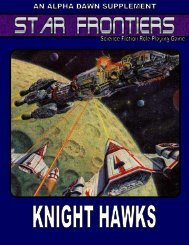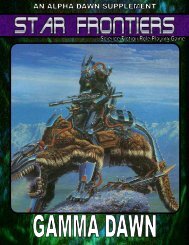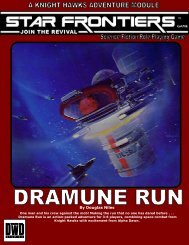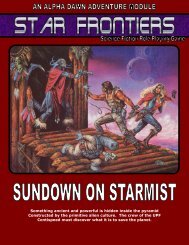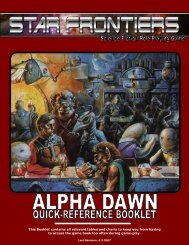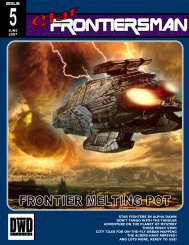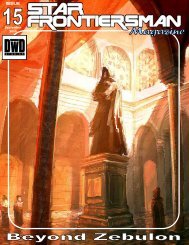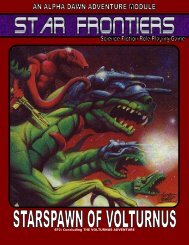Alpha Dawn - Star Frontiersman
Alpha Dawn - Star Frontiersman
Alpha Dawn - Star Frontiersman
You also want an ePaper? Increase the reach of your titles
YUMPU automatically turns print PDFs into web optimized ePapers that Google loves.
or small as you want to make them. An entire<br />
adventure could take place in a single building, or it<br />
could require the characters to travel halfway<br />
around a planet.<br />
The settings you select should have a purpose in the<br />
adventure. The players should be able to complete<br />
some part of their objective at each place. For<br />
example, when searching for someone lost in the<br />
wilderness, searchers can find important clues at the<br />
spot where the lost person was last seen, at the site<br />
of an old campfire, at a spot where they find a dead<br />
beast with a trail of blood leading away, etc. At each<br />
setting, players can discover the direction the<br />
person traveled, how long ago he was there and<br />
what has happened to him.<br />
When designing a setting, you should try to answer<br />
these questions:<br />
• What is the setting's purpose? When during the<br />
adventure will the characters arrive there? What<br />
information are the characters supposed to find<br />
there?<br />
• What does the setting look like? What are the most<br />
important features: where are trees and streams,<br />
doors and furniture?<br />
• What types of creatures, characters and events will<br />
the characters meet there? Are there any<br />
important plants or weather conditions, alarms or<br />
robots? These are not necessarily challenges to the<br />
players. They can be used to identify the area.<br />
• Are there any other important features about this<br />
setting? Does it limit movement in some way or<br />
hide things from sight? Does it have obstacles the<br />
characters must overcome?<br />
As you decide on each setting, write it down,<br />
including all special information about the setting.<br />
3<br />
Events<br />
Once you have chosen the theme and settings<br />
for an adventure, you must design the<br />
adventure itself. An adventure is divided into several<br />
smaller challenges that the players must overcome.<br />
Each of the challenges must be placed in a specific<br />
setting.<br />
When designing an adventure, first determine what<br />
events or challenges you want. Each event should<br />
provide an obstacle to overcome, a lesson to be<br />
learned or an opportunity to gain something that will<br />
aid the characters in reaching their goal. Events<br />
should always be exciting or provide a puzzle that<br />
the players must overcome with their wits. Follow<br />
each of these four steps when designing events.<br />
• Decide what purpose the event will fulfill. Is it an<br />
obstacle to fight or overcome? A puzzle to solve? A<br />
chance to gain something helpful? Or an event just<br />
to add excitement?<br />
• Determine all the elements needed in the event.<br />
Will the player characters encounter NPCs,<br />
creatures, robots, foul weather, physical obstacles<br />
or security systems?<br />
• Decide how NPCs, creatures or robots will react to<br />
the player characters, and what actions they will<br />
take.<br />
Random Events. Sometimes, referees may want to<br />
set up encounters or events that occur randomly,<br />
instead of being pre-planned. Usually, random<br />
encounters are tied to die rolls that are made at<br />
certain time intervals or when characters enter an<br />
area. For example, the referee could decide the<br />
characters have a 20% chance of being attacked by<br />
wild animals every night they spend in the<br />
mountains, or a 30% chance of meeting a criminal<br />
in a seedy part of town.<br />
Random events should be created when the<br />
adventure is designed. If you have only one random<br />
event, you can simply give it a percentage chance of<br />
happening. If you have more than one random<br />
event, you can arrange them on a table and assign<br />
a percentage chance that one will happen. Then, if<br />
there is a random event, you roll a second time to<br />
see which specific event happens. If you have more<br />
than one event, you can let each one happen only<br />
once, or let an event happen whenever it is rolled<br />
up.<br />
EXAMPLE: A referee wants to set up random<br />
encounters for characters that are searching for a<br />
missing caravan in a region with thick forests. He<br />
decides the chance for a random event is 20% every<br />
five hours. If the searchers have an encounter, he<br />
rolls 1 d10 on the Random Events table he made up.<br />
Die<br />
Roll Event<br />
1-2 Attacked by 5 flying shriekers<br />
3-4 Heavy rainstorm, the searchers must stop<br />
moving<br />
5-6 Attacked by 2 tree-cats<br />
7-8 Ground-monkeys steal a piece of equipment<br />
9-0 Searchers meet forest nomads<br />
Arranging Events. Once you have designed your<br />
events you must determine their order in the<br />
adventure. The events should lead step by-step to<br />
the goal. However, the order does not have to be<br />
strict and unbreakable. Players may be able to reach<br />
their goal using several different paths through the<br />
events. Some events may not lead anywhere, and<br />
players will need to return to an earlier encounter to<br />
find the right path.<br />
109



